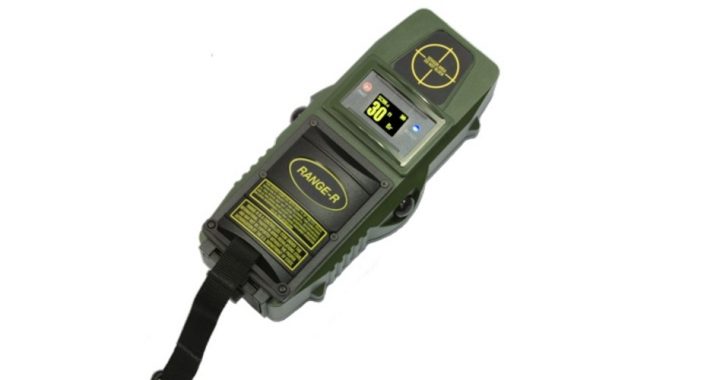
After serving jail time for committing an armed robbery, Steven Denson was out on parole. When he failed to report to his parole officer, authorities, after an intensive search, were about to conclude that Denson was gone for good.
Eventually, however, they found that Denson had opened an account for utilities services in Wichita, Kansas. Police obtained an arrest warrant and went out to see if he was home. It had just snowed and they noted footprints in the backyard and the utility meter spinning, giving them reasonable cause to believe that Denson was home.
Just to make sure, however, one of the officers pulled out his Range-R radar sensor (shown), held it against an outside wall, and determined that someone was inside. He wasn’t moving, just breathing, but the Range-R was sensitive enough to pick up his chest movement.
They entered and found Denson, arrested him, and doing a “quick search” of the premises, found a stash of weapons which, under the terms of his parole, was illegal for him to have.
He appealed his conviction to the Tenth Circuit Court of Appeals, complaining that his Fourth Amendment rights had been violated. He claimed that while the officers had an arrest warrant, they did not have a search warrant, and therefore evidence gained should be thrown out. In this case, wrote Judge Neil Gorsuch, “We confront … how the Fourth Amendment interacts with the government’s use of radar technology to peer inside a suspect’s home.”
As Gorsuch wrestled with the details of the case against Denson, he referred for guidance to a Supreme Court ruling, Florida v. Jardines, issued in 2013. Gorsuch found this, from Justice Antonin Scalia:
When it comes to the Fourth Amendment, the home is first among equals. At the Amendment’s very core stands “the right of a man to retreat into his own home and there be free from unreasonable government intrusion.”
This right would be of little practical value if the State’s agents could stand on a home’s porch or side garden and trawl for evidence with impunity; the [owner’s] right to retreat would be significantly diminished if the police could … observe his repose from just outside [his] front window.
In affirming the government’s case against Denson on other grounds, Gorsuch saw what’s coming:
The government brought with it a Doppler radar device capable of detecting from outside the home the presence of “human breathing and movement within.” All this packed into a hand-held unit “about 10 inches by 4 inches wide, 10 inches long.”
The government admits that it used the radar before entering [Denson’s residence] — and that the device registered someone’s presence inside.
It’s obvious to us and everyone else in this case that the government’s warrantless use of such a powerful tool to search inside homes poses grave Fourth Amendment questions….
We have little doubt that the radar device deployed here will soon generate many questions for this court and others.
One of the first such questions is: Just how long has this technology been around? And second, how many police departments have been using it without citizens’ knowledge? Answers: for more than two years, and 50 departments.
The Range-R, developed by L3 Communications, sends radar signals through walls (including concrete, brick, wood, stucco, glass, or adobe) up to 12 inches thick, which bounce off objects on the other side. If one of those objects is moving, even chest movements associated with breathing, the Range-R, using sophisticated software that measures the Doppler effect, can pinpoint the location of that movement, even as far away as 60 feet, and even if that movement is on the second floor or in the basement. As L3 proudly explains:
The sensitivity of the Range-R is sufficient to detect people breathing, making it difficult for individuals to hide from Range-R.
The range to a target is displayed on the user-friendly graphic display. Range-R covers a conical field of view of 160 degrees, sufficient to cover an entire room (or small building) in a single scan. The entire scan/detect sequence takes only a few seconds.
The National Institute of Justice (formerly known as the Law Enforcement Assistance Administration, or LEAA) did a survey of other models available on the market, including those that can be mounted on drones. In its Executive Summary, the NIJ explained:
TTWS [Through The Wall Sensors] allow for enhanced situational awareness during operations when knowledge of the presence of individuals behind opaque barriers would be of benefit, during law enforcement operations requiring forced entry, in hostage situations, in building sweeps by firefighters or when locating individuals during search-and-rescue operations….
Several [of these devices] initially intended for military use are being reengineered and repurposed for civilian law enforcement use.
When asked why it took an appeal to bring the use of this technology to people’s attention when it has been operational for more than two years, William Sorukas, a former Marshals Service official, answered: “If you disclose a technology or a method or a source, you’re telling the bad guys along with everyone else.”
At present, two lessons can be learned from these revelations. First, the government, including the police, will use whatever technology is available — whatever works — and leave concerns over the legal niceties behind, or address them only when someone complains. Second, the technology of personal surveillance is advancing so rapidly that it is racing ahead of constitutional concerns about its use.
A graduate of an Ivy League school and a former investment advisor, Bob is a regular contributor to The New American magazine and blogs frequently at www.LightFromTheRight.com, primarily on economics and politics.



